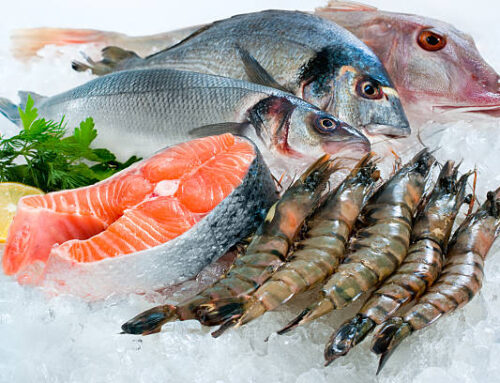The most common phosphates used in food processing are sodium salts, calcium salts, and potassium salts. There are also iron salts and zinc salts which function as nutritional fortification agents. There are more than 30 varieties of common food-grade phosphates.
Sodium phosphate salt is the primary type of phosphate consumed. However, with the development of food processing technology, the consumption of potassium phosphate salt is rising each year. Phosphates used as ingredients in food processing are based on their properties of water-solubility, water-retaining, emulsification, dispersion, chelation, hydrolytic stability, and other characters.

Properties of phosphates and their role in food processing
Phosphates have the following useful properties in food processing:
- Buffering effect
- Water-holding effect
- Chelation
- Protein role
- Bulking effect
- Anti-caking effect
- Extend food shelf life
- Mineral nutrient fortification
1. Buffering effect
The pH value of phosphate ranges from moderately acidic (around pH 4) to strongly alkaline (around pH 12). When different phosphates are combined in different ratios, various buffering levels can be obtained with pH stabilization between pH 4.5 and pH 11.7.
In the pH range of most foods (pH 3.5 to pH7.5), phosphates can be used as efficient pH regulators and pH stabilizers to improve the flavor of the food. The strongest buffering effect is for orthophosphates, and for polyphosphates, the buffering capacity decreases as the chain length increases.
2. Water-holding effect
Polyphosphate is a very hydrophilic water-retention agent and easily stabilizes water in food. Its water-holding capacity is related to the type of polyphosphate, the amount added, the pH value of the food, the ionic strength, and other factors. For meat products and seafood, the best water-holding capacity is pyrophosphate, followed by tripolyphosphate, and as the chain length increases, the water-holding capacity of polyphosphate is reduced.
3. Polyanion effect
Phosphates are used for the phosphorylation treatment of starch, dispersion of pigments, and emulsified foods (dairy products, ice cream, salads, sauces, etc.) They are also helpful as a dispersion stabilizer for sausages, minced meat products, and surimi products.
4. Chelation
Phosphates can extend the shelf life of food by preventing and delaying fat oxidation and slowing the spoiling of meat, poultry, and fish. They can also maintain the color of food.
5. Protein role
Phosphate has an enhancing effect on protein and gliadin. It improves the hydration and water-holding capacity of meat products, increases water permeability, promotes the softening of food, maintains flavor, and improves its overall quality. Phosphates in dairy products can prevent milk coagulation when heated by avoiding the separation of casein and water of fat.
6. Bulking effect
Acidic phosphates (e.g., acidic sodium pyrophosphate, calcium hydrogen phosphate) are commonly used as bulking agents for baked goods. The bicarbonate also reacts to provide the carbon dioxide needed for the baking process.
7. Anti-caking effect
Tricalcium phosphate is commonly used as an anti-caking agent to improve the free-flowing properties of powdered or hygroscopic foods.
8. Extension of shelf life
Polyphosphates enhance the storage stability of foods and extend the shelf life of products. This effect is mainly due to their:
- pH-regulating effect
- antibacterial effect
9. Mineral nutrient fortification
Calcium phosphate, magnesium phosphate, iron phosphate, and zinc phosphate are often used as mineral enhancers in food processing. The high solubility of iron phosphate and zinc phosphate enhances the biopharmaceutical effect of gastric juice and does not promote natural oxidation.
Phosphate safety issues
The safety of phosphates as a food additive is of great concern to people. There have been many scientific studies on the toxicology of phosphates, which have confirmed that they are non-toxic, safe food additives.
The Food and Agriculture Organization (FAO of the United Nations and the World Health Organization (WHO) has established the recommended daily intake for adults to be 1.4–1.5g P2O5, while the 1985 Food Additives Committee recommended an unconditional acceptance level of <30 mg/kg body weight and a conditional acceptance level of 30–70 mg/kg body weight for total phosphorus in the diet.
It must be noted here that in the application of food phosphates, we should pay attention to the balance of calcium and phosphorus (a calcium and phosphorus ratio of 1:1.2 is good) and the use of food additives in strict accordance with the provisions of health standards. Using food phosphates at reasonable levels will avoid the occurrence of calcium and phosphorus imbalance or abuse of phosphates that lead to adverse effects on human health.
Phosphates in food processing
1. Applications in the processing of meat and poultry products.
1.1 Improving the quality of meat products by:
a.Improving adhesion and slicing properties.
b. Improving water-holding capacity so that the meat products retain their natural moisture during processing and cooking, reducing loss of nutrients, preserving tenderness, and improving the yield of the finished product.
c. Raising pH to the range most suitable for protein swelling and producing the best color in meat products.
d. Improving emulsification performance and emulsion stability, and effectively preventing fat and water separation.
e. Chelating metal ions, delaying the oxidation reaction in the processing of meat products, and can effectively reduce the product rancidity rate, inhibit decolorization, and extend shelf life.
f. Improving processing performance and increasing production efficiency.
1.2 Improving the water-holding capacity of meat. This helps to maintain the meat’s moisture, which is directly related to the texture and yield of meat products. Phosphates also reduce boiling loss.
1.3 Rational use of phosphates in the processing of meat products.
Phosphates have a significant effect on the water retention of meat proteins (proteins extracted from meat). However, the magnitude of the effect of different types of phosphates on different parts of the meat varies.
The main order of factors affecting the water retention of thoracic muscle protein gels is sodium pyrophosphate > sodium tripolyphosphate > sodium hexametaphosphate.
The main order of factors affecting the water retention of leg protein gels is sodium hexametaphosphate > sodium pyrophosphate > sodium tripolyphosphate.
These different effects are mainly due to the different muscle types and the different mechanisms of phosphate action.
The significant effect of pyrophosphate on the water retention of brisket is attributed to the increase of pH by pyrophosphate, which increases the water retention of the gel through hydration, and the dissociation of actin into myosin and actin, which increases the water retention by binding water to protein molecules.
Phosphates are mainly used in cured meat products, such as ham, bacon, corned beef, roast beef, sausages, and poultry products.
In practice, the type of phosphate and the amount added should be selected according to the kind of meat product, texture, production processes, raw materials, and other factors, combined with the characteristics of various phosphates. By adding pyrophosphate to meat products, muscle proteins’ natural water retention capacity can be restored and enhanced, and polyphosphate can be quickly converted into pyrophosphate through the action of muscle enzymes so that the same effect can be achieved.
Although pyrophosphates have the best water retention effect, their solubility is so poor that they are generally used in combination with long-chain polyphosphates or potassium phosphates, which are more soluble.
a.To increase the effectiveness of different phosphates and other additives, compound phosphates are often used as meat improvers.
b.For the sausage and minced meat products, pyrophosphates and medium-chain length polyphosphates are usually added in dry powder form at the time of chopping. The pH value of the polyphosphates used is usually around 7, and sometimes polyphosphates with a pH value higher than 9 are used.
c. Phosphate complexes for saline injections must meet the following requirements:
- good solubility in ice brine
- high dissolution rate
The stability of phosphates in ice saline is good. The pH value of the compound phosphate used is generally 8.5–9.5. When preparing ice saline for injection, to achieve the best muscle protein activation, it is best to dissolve the phosphate in ice water first, and then add salt. This order generally cannot be reversed.
d. The amount of mixed phosphate added is generally 0.1%–0.4%, but the amount should be strictly controlled. If too much is added, it will damage the original flavor of the meat and affect the color due to the rise in pH value.
2. Applications in seafood processing.
2.1 Phosphates are used in large quantities in the processing of seafood, especially frozen seafood. This is because of their excellent water retention, pH regulation, and antifreeze properties, with the following effects:
a.Improving the water-holding capacity of seafood, making the meat juicier, and retaining nutrients and moisture.
b. Inhibiting the oxidation of fat and extending the shelf life of seafood.
c. Reduction of runoff loss after thawing and reduction of boiling weight loss.
d. Maintaining the natural color and flavor of seafood.
e. Synergizing with sugars to prevent freezing denaturation of surimi proteins.
2.2 In the processing of frozen shrimp, fish, and shellfish, the product is usually immersed in 3%–10% compound phosphate solution for processing (at a temperature below 10℃). The concentration of the soaking solution and soaking time depends on the type of shrimp, fish, shellfish, size, and fishing time.
The following factors should be considered when selecting phosphate complexes for immersion:
a. Can effectively improve the water-holding capacity of seafood.
b. Good solubility in ice water.
c. Can dissolve rapidly in ice water.
d. Good stability in ice water. The pH value of the compound phosphate used is generally higher than 9.
2.3 The complex phosphates added to minced frozen fish are usually sodium pyrophosphate, sodium tripolyphosphate, and sodium hexametaphosphate, and the amount added is 0.1–0.3% of the minced fish.
3. Application of phosphate in pasta products.
3.1 Application in bakery products: Acid phosphates (e.g., acidic sodium pyrophosphate, calcium hydrogen phosphate) are usually used as bulking acids, and bicarbonate reacts to provide the required carbon dioxide gas for the baking process. Different phosphates have different rates of reaction (ROR) in the raw dough, and the choice of phosphate depends on the desired baking results (volume of bulk, pore structure, taste). In addition, phosphates can be used as flour conditioners, dough improvers, buffers, and yeast nutrients.
3.2 Phosphates are widely used as noodle quality improvers in the processing of instant noodles and ordinary noodles, due to the following qualities:
a.Increasing the degree of starch pasting, increasing the water-absorption capacity of starch, increasing the water-holding capacity of dough, enabling instant noodles to rehydrate quickly and brew easily.
b. Enhancing the water-absorbing and swelling properties of gluten proteins, improving their elasticity, making the noodles smooth and glutenous, and improving resistance to cooking and soaking.
c. Stabilizing the pH value of dough, preventing discoloration and spoilage, and improving flavor and texture, due to the excellent buffering effect of phosphates.
d. Combining with metal cations in the dough, which has a “bridging” effect on the glucose group, forming cross-linking of starch molecules. This makes it resistant to high-temperature cooking, and the noodles fried at a high temperature can still maintain the viscoelastic characteristics of starch colloids after rehydration.
e. Improving the finish of the noodles.
4. Application in dairy products.
Phosphates are used as stabilizers and emulsifiers in sterilized milk, cream products, condensed milk, milk powder, coffee mates, dairy beverages, and cheese products with the following effects:
a.Buffering and pH-stabilizing.
b. Interaction with protein to disperse food ingredients, stabilize the emulsification system, enhance casein’s ability to bind water, and prevent protein, fat, and water separation.
c. Chelating multivalent metal ions, so that the protein coagulation precipitation is greatly reduced during the heating process and storage process. This improves the thermal and storage stability of milk. It can also delay lactose coagulation.
5. Phosphates are also widely used in the following food processing areas.
Beverages: used as acidity regulators, stabilizers, and mineral nutrient fortification agents.
- Potato products: Used as a stabilizer and color-preserving agent.
- Rice products: To improve the elasticity and taste of the products.
- Seasonings and instant soups: Stabilizers, acidity regulators.
- Hygroscopic powdered foods: Anti-caking and improvement of their free-flowing properties.
- Starch products and modified starches.
- Baby food, functional food: Mineral nutrient fortification.
Although pyrophosphate is the most effective, its solubility is very low in the presence of salt, and in most cases, it must be mixed with the more soluble long-chain sodium phosphate or potassium phosphate.
To take full advantage of the synergistic effect between various phosphates and other additives to meet the development needs of food processing technology, a variety of compound phosphates as food ingredients and functional additives should be used. The development and application of phosphate-based food additives have increasingly moved in the direction of compound phosphate research and development.




